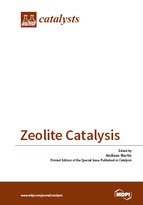Zeolite Catalysis
A special issue of Catalysts (ISSN 2073-4344). This special issue belongs to the section "Catalytic Materials".
Deadline for manuscript submissions: closed (31 October 2015) | Viewed by 84464
Special Issue Editor
Special Issue Information
Dear Colleagues,
The term zeolite is based on Greek words for “to boil” and “stone” and it is already known since more than 250 years. At that time, the Swedish mineralogist A.F. Cronstedt (1722-1765) observed the formation of large amount of steam when heating the material Stilbite pointing to his porous character and adsorption capacity. At present, over 200 different zeolite frameworks have been identified. In general, zeolites are crystalline aluminosilicates with defined micropore structure. Within zeolites, a good number of elements can be isomorphously incorporated and much more elements or their oxides can be hosted by zeolites. Besides their big variety in size of pore mouths, channels, crossings etc. leading also to their designation as molecular sieves and uses in membrane applications, zeolites reveal Brønsted and Lewis acidic properties that can be varied in wide limits as well. Thus, they deserve the name “solid acids”. Zeolites have an immense importance in diverse industrial applications as catalysts and adsorbents, for example in refinery industry, chemical industry, detergent sector or for solar thermal collectors and adsorption refrigeration
In this special issue we aim at new developments and recent progress with respect to zeolite-catalyzed chemical reactions, adsorption applications and membrane uses as well as improved syntheses strategies and characterization techniques.
Dr. Andreas Martin
Guest Editor
Manuscript Submission Information
Manuscripts should be submitted online at www.mdpi.com by registering and logging in to this website. Once you are registered, click here to go to the submission form. Manuscripts can be submitted until the deadline. All submissions that pass pre-check are peer-reviewed. Accepted papers will be published continuously in the journal (as soon as accepted) and will be listed together on the special issue website. Research articles, review articles as well as short communications are invited. For planned papers, a title and short abstract (about 100 words) can be sent to the Editorial Office for announcement on this website.
Submitted manuscripts should not have been published previously, nor be under consideration for publication elsewhere (except conference proceedings papers). All manuscripts are thoroughly refereed through a single-blind peer-review process. A guide for authors and other relevant information for submission of manuscripts is available on the Instructions for Authors page. Catalysts is an international peer-reviewed open access monthly journal published by MDPI.
Please visit the Instructions for Authors page before submitting a manuscript. The Article Processing Charge (APC) for publication in this open access journal is 2700 CHF (Swiss Francs). Submitted papers should be well formatted and use good English. Authors may use MDPI's English editing service prior to publication or during author revisions.
Keywords
- zeolites as adsorbents
- zeolites as acidic catalysts
- zeolites as hosts for catalytic active nanoparticles
- zeolites in fine chemical syntheses
- molecular sieve and inorganic membrane applications
- new zeolite synthesis routes
- sophisticated characterization techniques
- active sites in zeolites






